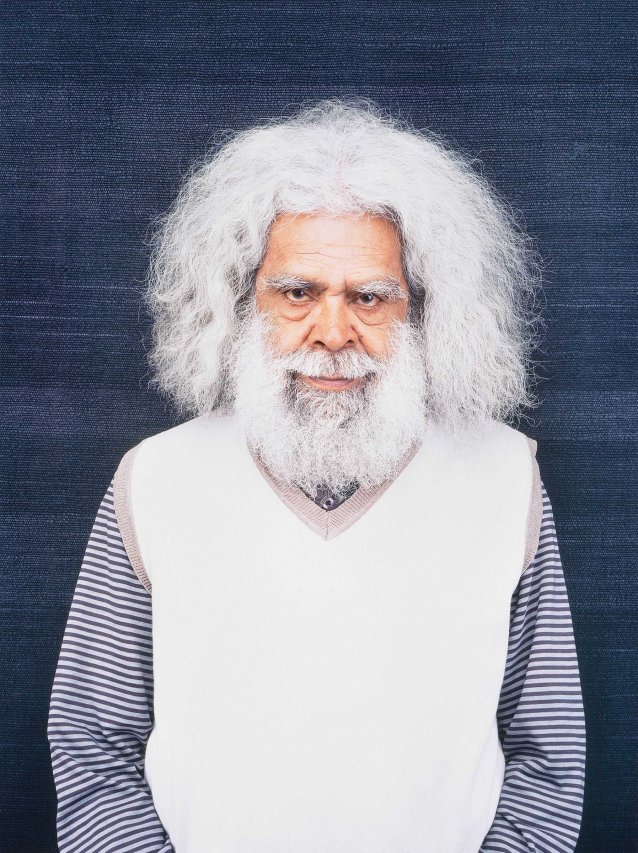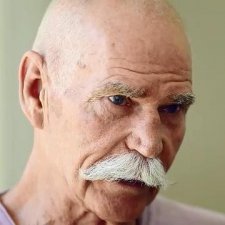- Well, you're all rugged up, mate.
- I live here.
- I've come down to warm you up.
- Have you?
- With conversation and my presence.
- I'm trying to work out, Jack.
- Yeah.
- Exactly where we met. But it's a bit hard, because I think we met more through the milieu certainly through the milieu of theatre and the Brand Factory mob.
- Yeah.
- So it's not a specific point, but more mutual friends and the world of theatre, really.
- [Jack] Yeah, yeah, yeah, yeah.
- [Rod] Yep.
- I remember you picking me up one time
- Mm-hm.
- From Smith Street and say, "Come up to the-
- "Come up, come to the loft."
- "I made a home studio up there."
- Yeah, yeah, yeah.
- And so you took the first photograph.
- First photograph, yep. In those early days, even when I was working as an actor at the Brand Factory, I'd just come from my first exhibition at Brummels. And already I was starting to hone my portraiture into a particular, quite personal structure, but also I was more far more intrigued by some of the more stark, very direct portraits from early on in portraiture in the 19th century. Now, there was a starkness and directness which came from the slow shutter speeds. They had no alternative. There was no spontaneity possible. You had to sit still and look into the camera, and for long periods of time. So I found that look into the camera so quietly intense. And there was nothing periphery around it. It was of such a direct engagement into the lens, through the lens, through the photographer, to the person viewing. A really powerful, singular connection. And that intrigued me much more than, say, trying to make whatever, someone look good this way or that way, or construct the image. I really liked that. So anyhow, come to the time where I'd had my first show over in Brummels. I was working with the actors in the Brand Factory. My milieu was spreading over to this sort of territory, and I started to systematically do portraits of my peers- fellow actors, writers, junkies, whatever we were into. And that's how Jack would've come into that, too. So that's how he became part of that original series.
- [Jack] Yes.
- [Rod] And that's how we really started forming a friendship. And from then on, over the years, whenever Jack was in the area, he come up for a cup of tea.
- [Jack] Yeah, yeah yeah.
- Or he was coming back from on the hill, where he'd been collecting the rent, so to speak- He'd pop in with his bags.
- Popping after a bit of time in Her Majesty's.
- Yeah, yeah. Come 'round when he was out.
- Of which I've got 22 mugshots of my own.
- [Rod] That's right!
- In the archives. And I'm very proud of them.
- [Rod] Yeah.
- We were talking about, Jack- and, really, the only family album we had-
- Yes.
- Were the mugshots-
- The mugshots.
- From times he did in jail over the years.
- Yeah, I remember, you used 17 of those 22 mugshots that I have in the Victorian archives. And just plastered one after the other. The many faces of me over the years. And I considered them, when I first saw the art, the equivalent of my missing childhood photographs that I never knew. But that portraiture was the- we did celebrate it as a renewal, a refreshing
- [Rod] Mm.
- Of somebody in my unique position, a survivor of the stolen generations.
- [Rod] Mm.
- And we hadn't made a big hullabaloo about that in those days.
- [Rod] Mm.
- But indeed, I was a survivor.
- [Rod] Mm.
- One of the acknowledged and well-known indigenous survivors of the stolen generations. There were, of course, white kids that were stolen, too.
- [Rod] Mm.
- And I was lumped in with them in the Box Hill Boys' Home as the only aboriginal feller in the Box Hill Boys' Home during my time there. So, reflecting on that face you see in that 2012, was it? Photographic Portraiture Prize-winning entry, because you could see, I saw myself in that photograph as a celebration of my longevity, my persistence in sticking with the art form that I love, treading the boards, fronting the camera. So I'm really proud of both of us for having done that. And I remember the times you wanted me to come up and just stand in front of that same wall, just to test out your focusing. Your ability to focus and all that. Take a snap or two, too.
- [Rod] It's getting harder. It's getting harder.
- [Jack] Yes.
- [Rod] Mm.
- Yeah. Well, so, that's been, you know, that's been our relationship for a long time. I still drop in, checking you out.
- [Rod] Yep.
- Seeing how you are.
- We have the odd coffee down at Rose's.
- Yeah. Yes, yes.
- [Rod] So, yeah, we're definitely village elders on Smith Street, that's for sure.
- [Jack] Yeah. We're the elders. Yes, yes. We're the song men of the Smith Street Strip. I'm the self-proclaimed feather foot, goodnight man, the law man of the Smith Street Strip, man beyond reproach. And everybody loves that, you know?
- [Rod] Everybody loves that.
- Because they've seen me at my worst on Smith Street. And you plucked me out of that world, insisting on a strong relationship with me over all those years. And that portraiture that you've done shows a young elder in the making. That's what it does. That's what it is. You know, so that's what you've done. See where you've landed people? See how far you've taken me.
- I don't think my photographs have done that.
- Well, it helps. All these little initiatives, all these little bits and pieces are part of the journey of my rise to, well, from infamy to fame, I like to say. That's been a blessing.
- Mm.
- I was a bit worried, because there's quite a few events over two days.
- Right, yeah.
- "How's Jack going to cope with all this?" Didn't have to worry Chatting up people. One of them come up to me and said, "I love him so much. I wanna put him in my pocket and taking home with me."














